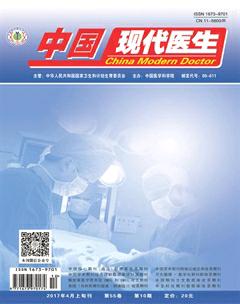瑞舒伐他汀對動脈粥樣硬化性心血管疾病調脂能力的研究
柯博熙++陸蓉
[摘要] 目的 探討動脈粥樣硬化性心血管疾病(ASCVD)患者應用瑞舒伐他汀(RSV)2周及3個月降脂幅度及降脂達標率,研究最佳治療方案,并觀察安全性。 方法 選擇2015年2月~2016年4月入住我院307例患者,按數字表法隨機分為RSV 10 mg組和20 mg組,治療2周和治療3個月后進行監測總膽固醇(TC)、低密度脂蛋白膽固醇(LDL-C)下降水平,及肝腎功能、心肌酶譜的變化,觀察藥物副反應。 結果 兩組患者基線水平的差異無統計學意義(P>0.05)。RSV 10 mg組和RSV 20 mg組治療2周后與基線比較,TC降低幅度均值達23.1%、29.8%(χ2=2.987,P=0.003),LDL-C降低幅度均值達29.4%、37.8%(χ2=12.105,P<0.001),LDL-C達標率為5.3%、19.2%(χ2=13.733,P<0.001),說明兩組間治療2周后TC、LDL-C降脂幅度、及LDL-C達標率比較,差異具有統計學意義。兩組治療3個月后再與基線比較,TC降低幅度均值達33.4%、45.1%(χ2=8.353,P<0.001),LDL-C降低幅度均值達46.5%、54.8%(χ2=10.222,P<0.001),LDL-C達標率為49.7%、70.5%(χ2=13.921,P<0.001),說明兩組間治療3個月后TC、LDL-C降脂幅度、及LDL-C達標率比較,差異具有統計學意義。 結論 我國ASCVD患者RSV 20 mg qd治療2周及3個月后,降脂幅度、達標率明顯高于RSV 10 mg qd,并且比較安全。
[關鍵詞] 動脈粥樣硬化性心血管疾病;瑞舒伐他汀;低密度脂蛋白膽固醇;達標率
[中圖分類號] R743.3 [文獻標識碼] B [文章編號] 1673-9701(2017)10-0035-04
Effect of rosuvastatin on lipid-regulating ability of atherosclerotic cardiovascular disease
KE Boxi1 LU Rong2
1.Department of Neurology, Taizhou Central Hospital in Zhejiang Province, Taizhou 318000, China; 2.Department of Anesthesiology, Taizhou Central Hospital in Zhejiang Province, Taizhou 318000, China
[Abstract] Objective To study the lipid-lowering range,lipid-lowering standard-reaching rate after application of rosuvastatin(RSV) for 2 weeks and 3 months in atherosclerotic cardiovascular disease(ASCVD) patients, and to study the best treatment regimen and observe the safety. Methods 307 patients admitted in our hospital from February 2015 to April 2016 were chosen and randomly divided into RSV 10 mg group and RSV 20 mg group.After treatment for 2 weeks and 3 months total cholesterol(TC), decrease levels of low density lipoprotein cholesterol(LDL-C), and the changes of liver,kidney function,and myocardial enzymes were monitored.And drug side effects were observed. Results There was no significant difference in the baseline level between the two groups(P>0.05). Compared with baseline, the mean reduction range of TC in the RSV10mg group and RSV 20 mg group after 2 weeks of treatment was 23.1% and 29.8% ,respectively, (χ2=2.987,P=0.003). The reduction range of LDL-C in the RSV10mg group and RSV 20 mg group was 29.4% and 37.8%(χ2=12.105, P<0.001), with the standard-reaching rate of 5.3%、19.2%(χ2=13.733,P<0.001), indicating that there was significant difference in TC, LDL-C lipid-lowering range and LDL-C standard-reaching rate between the two groups after the treatment for 2 weeks. Compared with baseline,the mean reduction range of TC in the RSV10 mg group and RSV 20mg group after 3 months of treatment was 33.4% and 45.1%(χ2=8.353, P<0.001). The reduction range of LDL-C in the two groups was 46.5% and 54.8%(χ2=10.222, P<0.001). And the standard-reaching rate of LDL-C in the two groups was 49.7%,70.5%(χ2=13.921, P<0.001), indicating that there was significant difference in TC, LDL-C lipid-lowering range and LDL-C standard-reaching rate between the two groups after the treatment for 3 months. Conclusion The range of lipid-lowering and standard-reaching rate of ASCVD patients after the treatment of RSV 20 mg qd for 2 weeks and 3 months were significantly higher than those after the treatment of RSV 10 mg qd for 2 weeks and 3 months, and the former treatment was safe.
[Key words] Atherosclerotic cardiovascular disease; Rosuvastatin; Low density lipoprotein cholesterol; Standard-reaching rate
動脈粥樣硬化性心血管疾病(atherosclerotic cardiovascular disease,ASCVD):新增加了缺血性卒中或短暫性腦缺血發作(transient ischemic attack,TIA),其他包括急性冠狀動脈綜合征、穩定性冠心病、血運重建術后、缺血性心肌病、外周動脈粥樣硬化病(peripheral atherosclerotic disease,PAD)等[1]。ASCVD的發病率和死亡率逐年增多,已成為全世界死亡的第一位,急需減少ASCVD的發生風險[2]。低密度脂蛋白膽固醇(low density lipoprotein cholesterol,LDL-C)是發生動脈粥樣硬化的最重要因素,與ASCVD發生顯著相關[3]。瑞舒伐他汀(rosuvastatin,RSV)是降低ASCVD的首選藥物之一。《2016中國成人血脂異常防治指南》把診斷為ASCVD歸為極高危人群,要求他汀治療3個月后,使LDL-C基線值下降50%,或者降至1.8 mmol/L以下[3],本研究以此為目標探討不同劑量RSV的LDL-C達標率,現報道如下。
1 資料與方法
1.1 一般資料
選擇2015年2月~2016年4月入住我院307例診斷為ASCVD患者,年齡45~80歲,依據ASCVD診斷標準[4]。排除標準:①2周內經他汀治療;②嚴重臟器功能不全;③腫瘤或全身免疫性疾病;④生命體征不穩定;⑤有肝病、肌病等病史;⑥拒絕參與實驗;⑦首次LDL-C<2.6 mmol/L;⑧有藥物過敏史。本研究經醫院醫學倫理委員會批準,所有治療獲得患者或其家屬知情同意。按數字表法隨機分為2組:RSV 10 mg組151例和RSV 20 mg組156例。
1.2 方法
給予RSV 10 mg qd和20 mg qd(可定片,阿斯利康制藥公司,生產批號1412122)。入組后立即服用,每日一次,連續口服3個月以上。其他藥物:給予抗血小板聚集及調控血壓、血糖等治療,輔助藥物各組無明顯差異。
1.3 觀察指標
研究兩組治療2周、3個月的TC、LDL-C下降幅度及降脂LDL-C達標率,觀察藥物副反應如肝腎功能、心肌酶的變化。詳細記錄臨床基線資料,見表1。
1.4 統計學分析
采用統計SPSS23.0軟件,計量資料采用(x±s)表示,組間比較采用獨立樣本t檢驗及方差分析,計數資料組間比較采用χ2分析,按P<0.05為差異具有統計學意義。
2 結果
2.1 兩組基線資料比較
兩組患者除年齡外,在性別、年齡、煙酒史及高血壓史、糖尿病史、冠心病、腦梗死、TIA、PAD、血脂基線水平等基礎疾病上的差異無統計學意義(P>0.05)。
2.2 兩組治療后調脂比較
RSV10 mg組和RSV 20 mg組治療2周后與基線比較,TC降低幅度均值達23.1%、29.8%(χ2=3.987,P=0.003),LDL-C降低幅度均值達29.4%、37.8%(χ2 =12.105,P<0.001),LDL-C達標率為5.3%、19.2%(χ2=13.733,P<0.001),表示兩組間治療2周后TC、LDL-C降脂幅度及LDL-C達標率比較,差異具有統計學意義。兩組治療3個月后再與基線比較,TC降低幅度均值達33.4%、45.1%(χ2=8.353,P<0.001),LDL-C降低幅度均值達46.5%、54.8%(χ2=10.222,P<0.001),LDL-C達標率為49.7%、70.5%(χ2=13.921,P<0.001),表示兩組間治療3個月后TC、LDL-C降脂幅度及LDL-C達標率比較,差異具有統計學意義。故可以認為RSV 20 mg組降脂幅度、達標率明顯高于RSV 10 mg組。見表2。
2.3 兩組副反應比較
治療3個月后,RSV 20 mg組出現4例輕度轉氨酶升高(正常2倍內),1例輕度腎功能異常,RSV10 mg組發現3例輕度轉氨酶升高(正常1倍內),兩組無需停用、減量,2~4周后恢復正常范圍。兩組心肌酶譜無變化。
3 討論
動脈多血管床病變和腦梗死等關系密切[5],Saam T等研究認為中國人群斑塊具有纖維帽薄、富含脂質的壞死核心體積大的特點[6],更容易破裂風險,LDL-C和斑塊密切相關導致ASCVD事件發生已被證實。而他汀具有全面調節血脂和抗炎作用[7],其中RSV是國內外公認的降低LDL-C強效的藥物之一,但大量的證據來自于國外,國內的他汀劑量-效應關系缺乏大樣本研究。本研究比較不同劑量RSV對ASCVD患者治療2周(短期)和3個月(中期)的調脂能力,研究最適合國人的他汀劑量。
研究他汀逆轉斑塊不得不提REVERSAL研究[8],是最早應用血管內超聲的研究。該研究比較18個月的普伐他汀40 mg/d或阿托伐他汀80 mg/d治療502例冠心病患者的動脈粥樣硬化斑塊總體積變化,結果顯示強化他汀治療LDL-C降低至1.8 mmol/L可以阻止冠狀動脈斑塊的進展,奠定了他汀治療ASCVD的基石。ASTEROID研究比較RSV 40 mg/d治療507例患者冠脈斑塊的變化,證實24個月的強化RSV治療可以顯著減少冠脈管腔直徑狹窄百分比,可以逆轉斑塊[9]。Nicholls研究[10]比較RSV 40 mg/d或阿托伐他汀80 mg/d治療104周后1385例患者冠脈斑塊的變化,RSV 40 mg/d較阿托伐他汀80 mg/d能更顯著的降低LDL-C水平。R?覿ber研究[11]比較RSV 40 mg/d治療13個月后的103例急性ST段抬高型心肌梗死患者的非梗死相關動脈的斑塊變化,也顯示強化他汀治療降低LDL-C至1.8 mmol/L可以逆轉冠脈斑塊。以上研究為歐美人群他汀療效對比,因種族差異,RSV 2013年英文說明書指出,40 mg/d禁用于亞裔人群。關于亞裔人群研究,ARTMAP研究比較常規劑量阿托伐他汀20 mg/d或RSV10 mg/d治療6月對350例韓國人群輕度冠脈動脈粥樣硬化患者斑塊體積的影響,結果顯示兩種藥物治療均顯著降低LDL-C[12]。Lawitz[13]研究比較RSV 16.9 mg/d治療76周對日本人群214例穩定型冠心病患者斑塊的變化。結果顯示動脈粥樣硬化斑塊總體積中位數降低了6.5%,并實現斑塊逆轉。腦梗死也能獲益,血脂中尤其是LDL-C高是腦梗死的高危因素[14],Tsivgoulis等[15]研究指出在卒中之前使用他汀與良好預后獨立相關,為他汀在腦梗死的獲益增加新的證據[15]。Takayama T認為無論是高劑量和低劑量RSV均增加斑塊的穩定性,高劑量比低劑量RSV逆轉斑塊更有效[16]。上述幾項著名研究,肯定了RSV等強效他汀的療效,但均是國外的研究,治療半年以上(長期)降低LDL-C的對比觀察。本研究納入了307例中國漢族ASCVD患者,研究對比RSV 10 mg qd和20 mg qd兩組的短期、中期的療效,結果顯示RSV 10 mg組和RSV 20 mg組治療2周后,TC降低幅度、LDL-C降低幅度、LDL-C達標率比較,差異具有統計學意義(P<0.05);治療3個月后,兩組各項指標差異更顯著(P<0.001),LDL-C達標率為49.7% vs 70.5%。表明RSV 20 mg組較RSV 10 mg組有更顯著降脂幅度,LDL-C達標率高。副作用少,降脂是相對安全的。
他汀還具有抗炎、抗氧化、改善內皮細胞功能的作用[17],特別是抗炎作用成為新熱點,Doug Weeks等[18]研究認為他汀還可以使感染風險下降58%。Panes O等[19]認為RSV多效性,可以調節血小板全血組織因子促凝活性,成為防治動脈粥樣硬化的新目標。Kata D等[20]認為RSV具有小膠質細胞的抗炎作用,可治療相關的神經系統疾病。
綜上所述,他汀應用廣泛,我國ASCVD患者應用RSV 20 mg/d,早期啟動并持續3個月,能獲得好的降脂幅度,取得更高LDL-C達標率,耐受性良好。終點事件也在觀察隨訪中,然而本研究也存在單中心研究、樣本量不夠大等不足,需要進一步臨床證實。
[參考文獻]
[1] 諸駿仁,高潤霖,趙水平,等.中國成人血脂異常防治指南(2016年修訂版)[J].中國循環雜志,2016,(10):937-953.
[2] An International Atherosclerosis Society Position Paper.Global recommendations for the management of dyslipidemia-full report[J].J Clin Lipidol,2014,8(1):29-60.
[3] Libby P,Theroux P.Pathophysiology of coronary artery disease[J]. Circulation,2005,111(25):3481-3488.
[4] 廖玉華,程翔,黃愷,等.ASCVD患者逆轉斑塊他汀治療專家共識[J].臨床心血管病雜志,2015,(1):1-5.
[5] 柯博熙,陸蓉,陳秋月,等.隱匿性腦梗死和多血管床病變相關性研究[J].中國現代醫生,2016,54(33):8-11.
[6] Saam T,Cai JM,Cai YQ,et al.Carotid plaque composition differs between ethno-racial groups:An MRI pilot study comparing mainland Chinese and American Caucasian patients[J]. Arterioscler Thromb Vasc Biol,2005, 25(3):611-616.
[7] Puri R,Libby P,Nissen SE,et al.Long-term effects of maximally intensive statin therapy on changes in coronary atheroma composition:Insights from SATURN[J].Eur Heart J Cardiovasc Imaging,2014,15(4):380-388.
[8] Nissen SE,Tuzcu EM,Schoenhagen P,et al.Effect of intensive compared with moderate lipid-lowering therapy on progression of coronary atherosclerosis:A randomized controlled trial[J].JAMA,2004,291(9):1071-1080.
[9] Nissen SE,Nicholls SJ,Sipahi I,et al.Effect of very high-intensity statin therapy on regression of coronary atherosclerosis:The ASTEROID trial[J].JAMA,2006,295(13):1556-1565.
[10] Nicholls SJ,Borgman M,Nissen SE,et al.Impact of statins on progression of atherosclerosis: rationale and design of SATURN(Study of Coronary Atheroma by InTravascular Ultrasound: effect of Rosuvastatin versus AtorvastatiN)[J].Curr Med Res Opin,2011,27(6):1119-29.
[11] R?覿ber L,Taniwaki M,Zaugg S,et al.Effect of high-intensity statin therapy on atherosclerosis in non-infarct-related coronary arteries(IBIS-4):A serial intravascular ultrasonography study[J].Eur Heart J,2015,36(8):490-500.
[12] Lee CW,Kang SJ,Ahn JM,et al.Comparison of effects of atorvastatin (20 mg) versus rosuvastatin(10 mg)therapy on mild coronary atherosclerotic plaques (from the ARTMAP trial)[J].Am J Cardiol,2012,109(12):1700-1704.
[13] Lawitz E,Sulkowski MS,Ghalib R,et al.Simeprevir plus sofosbuvir,with or without ribavirin,to treat chronic infection with hepatitis C virus genotype 1 in non-responders to pegylated interferon and ribavirin and treatment-naive patients:The COSMOS randomised study[J]. Lancet,2014,384(9956):1756-1765.
[14] Biswas N,Sangma MA.Serum LDL(Low Density Lipoprotein)As a Risk Factor for Ischemic Stroke[J]. Mymensingh Med J,2016,25(3):425-432.
[15] Tsivgoulis G,Katsanos AH,Sharma VK,et al.Statin pretreatment is associated with better outcomes in large artery atherosclerotic stroke[J]. Neurology,2016,86(12): 1103-1111.
[16] Takayama T,Komatsu S,Ueda Y,et al.Comparison of the Effect of Rosuvastatin 2.5 mg vs 20 mg on coronary plaque determined by angioscopy and intravascular ultrasound in Japanese with stable angina pectoris(from the aggressive lipid-lowering treatment approach using intensive rosuvastatin for vulnerable coronary artery plaque[ALTAIR] randomized trial)[J].Am J Cardiol,2016,117(8):1206-1212.
[17] Sillesen H.Statins and their use in preventing carotid disease[J].Curr Atheroscler Rep, 2009,11(4):309-314.
[18] Weeks DL,Greer CL,Willson MN.Statin medication use and nosocomial infection risk in the acute phase of stroke[J].J Stroke Cerebrovasc Dis,2016,25(10):2360-2367.
[19] Panes O,González C,Hidalgo P,et al.Platelet tissue factor activity and membrane cholesterol are increased in hypercholesterolemia and normalized by rosuvastatin,but not by atorvastatin[J].Atherosclerosis,2016,257:164-171.
[20] Kata D,F?觟ldesi I,Feher LZ,et al.Rosuvastatin enhances anti-inflammatory and inhibits pro-inflammatory functions in cultured microglial cells[J].Neuroscience,2016, 314:47-63.
(收稿日期:2017-02-14)

